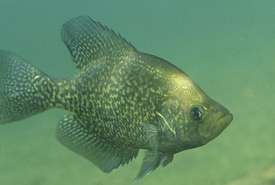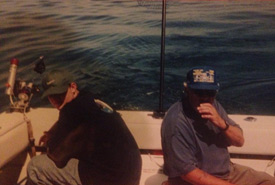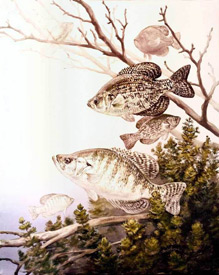Of crappies and conservation

Black crappie (Photo by Eric Engbretson, USFWS)
If you've ever tossed a line into freshwater in eastern North America, there's a good chance that you've hooked a feisty, speckled panfish that puts up quite the struggle and is a year-round favourite of anglers everywhere.
They go by a number of names: white perch, specks, slabs, calico bass, papermouths, strawberry bass, moonfish, sac-a-lait (in Louisiana Cajun French) and marigane noire (in Quebec), but most people know them by their universal name, crappies.
My first introduction to nature came via fishing trips to the ponds, lakes, and rivers that populated Northeast Ohio, where I grew up before I moved to Ontario. As a young angler, all of the shimmery, wiggling, finned aquatic denizens that I enticed into nibbling my bait or lure fascinated me, but the crappie continues to hold a special place in my memory.
My fishermen father and grandfather both instilled in me an appreciation for waterways and the creatures that call those habitats home at an early age.

Me fishing with my grandfather in the early 1990s. (Photo by Jarret Ruminski)
Some of my fondest memories involve trips to the lake with my grandfather, a guy whose knowledge of all things finned and gilled seemed unparalleled to my young mind. We'd rise at the crack of dawn (fishing was the only thing that roused my otherwise morning-loathing self) and arrive at the lake just at the sun peeked over the horizon. Our baited lines created distinctive rings on the water's fog-cloaked glass surface, and within minutes we were reeling in the crappies. Both species (black and white crappies) took most any kind of reasonably sized bait or lure, from flies, to plastic worms, to wriggly minnows. Whether we took them home or released them, catching crappies provided me with real connections, both to my grandfather and to nature.
One particular trip to the lake stands out in my memory to this day. My grandfather had found a small, concrete bridge that crossed a narrow channel of Lake Evans, and we'd tossed our lines into the water while sitting on the bridge’s outcroppings. This unleashed a feeding frenzy, as dozens of black and white crappies who had gathered near the bridge's submerged foundations eventually filled our stringers.
Those little crappies gave me an unforgettable day in the outdoors, and ever since I've tried to repay them by promoting the importance of protecting and conserving their (and our) habitats.

Black and white crappies (Illustration by Robert W. Hines/USFWS, Wikimedia Commons)
You can find crappies in ponds, lakes and rivers throughout much of Canada. Maxing out at around five pounds, they're the perfect fish for all seasons. Anglers of any age can catch them during the spring spawn right up through the winter, when they provide plenty of thrills through the ice. Even non-anglers can get a glimpse of crappies flitting about in the clear shallows near shorelines throughout the year, or as staples of freshwater aquariums.
Though common, crappies can serve as important black-and-white speckled conservation ambassadors. The best way to appreciate the value of nature is to experience it first-hand, and fishing for the always-available crappie is a great way to see, feel and smell outdoor life.
Crappies also play an important role in freshwater ecosystems; as mid-level predators, they help measure and control prey species populations in lakes. Moreover, crappies can make use of real Christmas trees that you can donate to conservation organizations to use as underwater habitat cover. The Christmas trees are anchored to streambanks to create this habitat as described in this Nature Conservancy of Canada Conservation Volunteers' blog.
I have the crappie (and my grandfather) to thank for introducing me to the natural world. The next time you find yourself near any fish-supporting body of water, seek out the humble crappie, and do what you can to help protect aquatic habitat — for the crappie’s benefit as well as ours.


